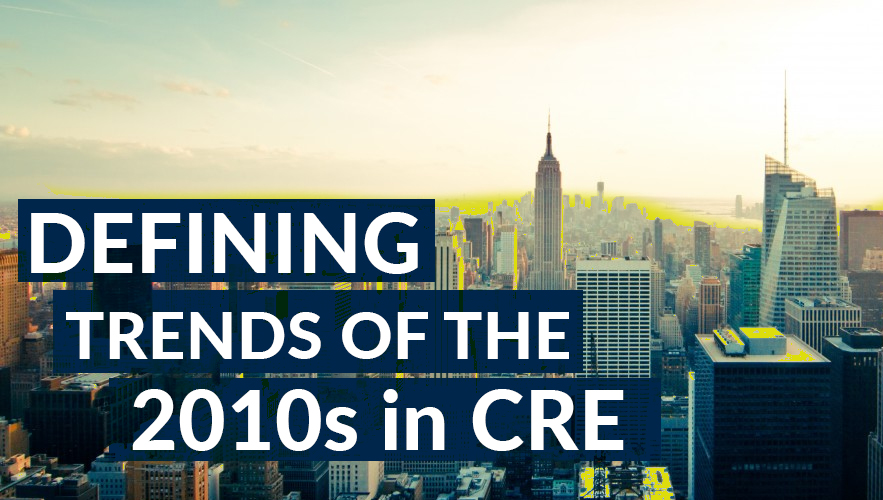Defining Trends From the 2010s in Commercial Real Estate

This blog explores fundamental and significant changes in the commercial real estate industry that occurred throughout the 2010s, and how those developments will shape our CRE climate for years to come.
The Multifamily Sector Post-Recession Renting Shift
The multifamily sector has evolved to become a notable property type of the decade – highly in demand and divided into Class A and otherwise. Multifamily only accounted for approximately 9% of the total number of residential units prior to the recession and now is closer to 27%. Despite an increase in construction, apartment supply hasn’t met demand and occupancy rates remain high. National occupancy rate hit 95.8% in the second quarter of 2019, an increase from 95.4% in 2018’s second quarter – this is the highest occupancy rate since 2001!
Other factors during the 2010s have reshaped this sector as well. The push for homeownership was more important in years past, as apartments were perceived as transitional and where you lived prior to buying a home. However, renting has become less looked down upon and more mainstream – homeownership is possible in an apartment. This change has been mainly attributed to Millennials, who now have an overwhelming presence in the housing and job markets.
New attitudes about renting have also changed city living, reshaping urban parts of the country during the past decade. With good quality multifamily real estate flourishing in cities, urban growth has continued. Residential developments have supported the expansion of urban environments, feeding the urban core of cities and making them more livable environments.
Office relocation to urban areas has also fueled the demand for multifamily housing in cities, as younger employees are seeking city living to take advantage of transportation, restaurants, entertainment and other amenities available. Changes to the apartment market during the past 10 years has encouraged growth in urban areas and coastal gateway markets as well.
Industrial Properties – Hubs for E-commerce
During the past decade, we’ve seen industrial real estate market expand significantly to serve the vast online retail market. This change is attributed to the shift to online buying habits of U.S. consumers. In 2010, online sales made up just 4% of all retail sales. By mid 2019, this total increased to over 11% of all retail sales and shows no sign of slowing.
From 2010 and beyond, online buying has accelerated due to giant online retailers such as Amazon.com which boasts ease-of-use and everything available at the convenience of a click. In the early 2010s, smartphones didn’t have any significance with regards to online shopping. Now, they account for approximately 40% of online retail sales. Due to this surge in e-commerce, logistics properties have experienced a new demand. Although traditional industrial hubs are handling the majority of new demand for last-mile transportation, smaller buildings are also being developed closer to urban centers. Additionally, increased speed of delivery of retail goods is also restructuring systems within industrial properties as Amazon pushes onward towards same-day delivery. Retailers and logistics partners are struggling to accommodate the accelerating e-commerce market, as many older warehouse spaces aren’t ideal for today’s automated sorting, storage and retrieval systems.
Retail faced the most challenges in this past decade, although much of U.S. core retail is going strong and it’s still unclear whether this has been a permanent change due to online shopping popularity, or simply a fading out of weaker brands. Big-box stores and lower-end malls (Class-B and C) have struggled while Class-A malls and upper-end retail and properties continue to thrive. Discount retail also flourished throughout the decade, initially spurred by the need for cheaper goods but later solidified as they established themselves as good places to purchase everyday items. Chains like Dollar General expanded greatly over recent years.
Office Properties & Co-Working
Years ago, offices existed solely as places of business. Now the modern office encompasses much more—expanding to emphasize worker communication, hospitality, technology and an increase in creative amenities. No sole factor is responsible for the change, instead the shift to new ideas from the large new workforce about what work should be, and the significant advances in communications technology. Millennials are increasingly seeking better remote work options including connectivity, technology, flexible desk options, amenities and collaborative and private space. Thus, a new industry arose—co-working. Flexible office space has become a permanent need!
Open-plan offices increased in popularity with fewer people wanting cubicle confinement or a single work location. Thus, the shared office space was born, both collaboration and communication driven.
As a leading commercial real estate advisory company, Progress Capital is dedicated to providing our audience with relevant market news and insights. Please check back regularly to stay updated with current CRE trends and resources.
